

| Eakring Birds |
| Systematic list and summary 2009 |
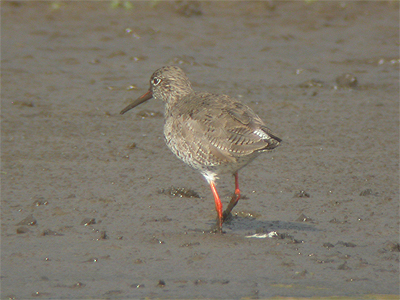 |
A year list ending on 125
species, meant that 2009 was never going to be the best
of years, but was by no means without it's highlights and
the typical range of semi-rarities that often occur on
passage here. A period of raptor passage in April produced Red Kite, Marsh Harrier and Hen Harrier (the first of three in 2009) all on the same morning. Other highlights included an adult Kittiwake in March, two Ring Ouzels near Kersall in late August and a fly over Rock Pipit in October. Another feature of the year was a very welcome increase in the range and numbers of wildfowl at Eakring Flash during the Autumn and early Winter, which were probably the best recorded here since 2003. |
|
| ......... | ||
| To end the year, a very cold spell with heavy snow in some parts of the UK, caused some good cold weather movements through the area, in the run up to Christmas. | ||
| ......... | ||
| Wildfowl
counts 2009 seemed as though wildfowl counts throughout the year would continue to decrease, but October, November and December saw a return to similar counts of around a decade ago. This was through a recommendation to cut back some of the surrounding Sallow growth, opening up the flash and increasing Eakring Flash's attractiveness to wildfowl. The effect was virtually instantaneous and resulted in peak counts of 103 Mallard and 62 Teal in November. |
||
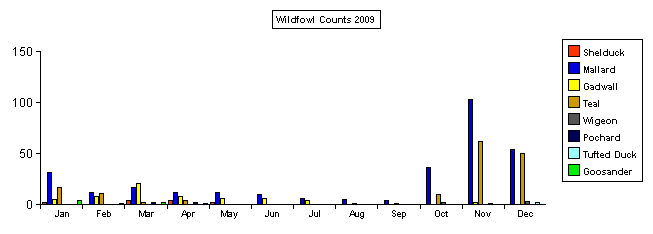 |
||
| The systematic list follows that used in the British Birds List of Birds of the Western Palearctic (1997)... | ||
| Little Grebe Tachybaptus ruficollis |
| Little Grebe has become increasingly more uncommon here and this again continued into 2009. The year's only record, was of a pair at Eakring Flash from April 23rd and remaining into May, when a breeding attempt failed. |
| ......... |
| Cormorant Phalacrocorax carbo carbo |
| Noted regularly throughout the year. Birds typically passed over Eakring Flash from Trent Valley sites, on their way to feed at other local waters, but occasionally hunted at Eakring Flash. No unusually large counts were made and records would involve single birds. |
| ......... |
| Grey Heron Ardea cinerea |
| Between one and three birds were present in the area almost daily throughout the year, but a record count came on March 7th, when there were four at Eakring Flash and four in fields at Eakring Field Farm. |
| Mute Swan Cygnus olor |
| Throughout the course of the Winter, a large group of Mute Swan had been present in fields near Wellow and peaked at 21 on February 26th. Early in March, the group moved to Oil-seed Rape fields between Eakring Flash and Leyfields farm, producing a peak of 29 on March 5th and then over 20 birds were present daily till the end of March. This count also included the resident pair from Eakring Flash, which bred successfully at Eakring Flash for the first time, producing two young in June. After a period of heavy rain, shortly after hatching, the family were found in the pastures area and herded by local farmers back to Eakring Flash, when they promptly disappeared and were not seen again. Later in the year, a count of 11 was made on December 13th. |
| ......... |
| Whooper Swan Cygnus cygnus |
| Two flew west over Eakring Flash on January 31st. |
| ......... |
| Pink-footed
Goose Anser
brachyrhynchus |
||
| Two skiens in the first few months of the
year were approximately 81 west over Eakring Flash on
January 31st and 168 moving west on February 1st. There were just two skiens noted during the Autumn, with 53 moving west on September 12th (the area's earliest ever Autumn record) and then 214 moving north-west on November 8th. |
||
| ......... |
| Greylag Goose Anser anser |
| The usual regular Spring sightings of 1/2 birds were made during late February and into April. The highest count was of 15 south on December 13th, which included an off white coloured bird. |
| ......... |
| Canada Goose Branta canadensis |
| Surprisingly uncommon with very few sightings throughout the course of the year. There was no recorded breeding. |
| ......... |
| Shelduck Tadorna tadorna |
| A pair returned to Eakring Flash on January 10th and were seen on numerous dates until late May, but increasingly favoured Tug Bridge Farm and fields at Church Hill. Four (two pairs) were at Eakring Flash on March 10th. |
| ......... |
| Wigeon Anas penelope |
| There were a couple of Autumn/Winter records. Two were at Eakring Flash on October 10th and three at Eakring Flash on December 13th, before flying off south-west. |
| ......... |
| Gadwall Anas strepera |
| Birds were present at
Eakring Flash on many dates from January to July, with
occasional records from Penny Pasture Common, Eakring
Meadows and Kersall pond. A maximum count of 21 at Eakring Flash on March 5th, was exceptional on recent years, with 14 still present at Eakring Flash on March 10th. Breeding was confined to just three pairs this year (two at Eakring Flash and one at Penny Pasture Common) with only one pair seen to produce young. |
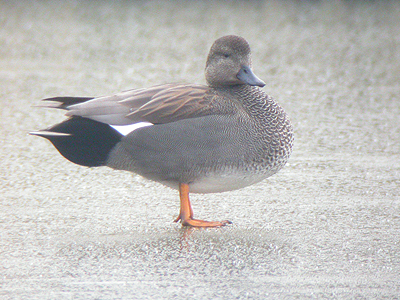 |
|
| ......... | ||
| Teal Anas crecca |
|||
| Counts during the early months of 2009 were quite typical for recent years. Ten at Eakring Flash and Penny Pasture Common on January 18th, rose to 15 at both sites by January 29th. A highest April count of just four came on April 9th. There were then no records until a single at Eakring Flash on August 30th and another on September 20th. Counts increased from seven at Eakring Flash (October 24th) to a maximum of 62 at Eakring Flash on November 15th. The only other notable counts were 26 at Eakring Flash on November 21st and 50 there on December 26th. These were the largest counts for many years. | |||
| ......... | |||
| Mallard Anas platyrhychos |
| Another species which was to produce it's best count here since the early 2000's. During the early months of the year, a maximum count of 27 came on January 18th. Following a poor breeding season, when there was just six pairs present at four sites, numbers increased from 32 at Eakring Flash on October 29th and then 50 on November 5th, to reach a high of 103 at Eakring Flash on November 21st. Numbers dropped afterwards, but still reached a very high 71 at Eakring Flash on December 5th. |
| ......... |
| Shoveler Anas clypeata |
| A welcome series of records following a female at Eakring Flash on October 2nd, which was the first Shoveler here since 2005. The same (or a different female) was present at Eakring Flash from November 21st - December 2nd and then two females were at Eakring Flash on December 12th. |
| ......... |
| Pochard Aythya ferina |
| Another poor showing this year with just two records. A male was at Eakring Flash on April 16th, which is a rather typical date for Pochard here, unlike the female at Eakring Flash on November 28th. |
| .... |
| Tufted Duck Aythya fuligula |
| Just three records of this former breeding species. Two were at Eakring Flash (April 13th) followed by four at Eakring Flash on May 10th. An unusual date late in the year, with two presnt at Eakring Flash on December 13-14th. |
| ......... |
| Goosander Mergus merganser |
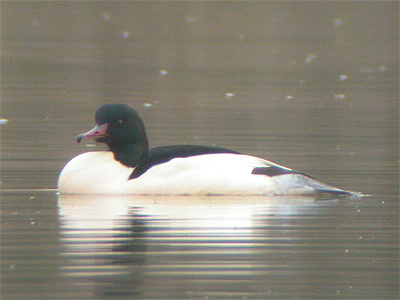 |
Only recorded during the period January to
April, with a series of records which included a drake
moving east over Eakring Flash on January 4th, three (1m,
2f) at Eakring Flash on January 22nd, two (2f) at Eakring
Flash on January 23rd, two (1m, 1f) at Eakring Flash on
January 24th, three (1m, 2f) at Eakring Flash on January
29th and a male and three/four females at Eakring Flash
on January 30th and four (1m, 3f) at Eakring Flash on
January 31st. The only other records were a female at Eakring Flash on February 1st, a pair at Eakring Flash on March 26th and a male moving south on April 2nd. |
|
| .... | ||
| Red Kite Milvus milvus |
| Apart
from Common Buzzard, Red Kite is now the commonest of the
large raptors at Eakring. During 2009, there were a
record four sightings, two in Spring and two in Autumn. One over Red Hill, eventually drifted off north-east over Lound Wood on April 21st, followed by a different bird the next morning, which was seen to leave it's overnight roost at Lound Wood, before drifting off north on April 22nd. Early August saw two further records in quick succession, when an immature over Eakring Flash, before drifting off low south-west on August 1st, then an adult drifting south-west over Tug Bridge Farm on August 6th. |
| ......... |
| Marsh Harrier Circus aeruginosus |
| A female moving west over Eakring Flash, u-turned and was seen later the same morning moving low south over Penny Pasture Common and Eakring Field Farm on April 23rd and was the first Eakring record since 2004. The same day also saw Red Kite and Hen Harrier through the area. |
| ......... |
| Hen Harrier Circus cyaneus |
| There were an unprecedented three records during the year, of a raptor which has always been extremely rare here. The Spring saw two of the year's records, with a female/immature in the Eakring Flash area from March 28-29th and another female/immature in the Red Hill and Eakring Flash area on April 22-23rd. A female/immature was noted moving south-west over Lound Wood and Red Hill on October 29th. |
| ......... |
| Sparrowhawk Accipiter nisus |
| Two breeding pairs were again in territories at opposite ends of the recording area during the year. Some definite migrants (all single birds) were noted moving north through the area on April 18th, 21st, 23rd and May 7th. |
| ......... |
| Common Buzzard Buteo buteo |
| Present throughout the year, with one to four birds in the area on numerous dates. Peak counts occurred with 13 on March 15th (with nine in the air together over Hare Hill Wood) eight on April 13th and seven on October 22nd. |
| ......... |
| Kestrel Falco tinnunculus |
| Common all year, with three pairs breeding in the area. |
| ......... |
| Merlin Falco columbarius |
||
| Just one record this year, of a female moving east over Lound Wood on November 21st. | ||
| ......... |
| Hobby Falco subbuteo |
| There was just one Spring record of two
birds over Eakring Flash, that eventually flew off north
on May 9th. There were no further records until one at Eakring Meadows on August 10th, followed by another seen near Eakring village on August 13th. Two birds were over Leyfields on August 23rd, before a juvenile was noted moving west on August 27th. During September, there was a family party of three birds in the area, which were noted on three occasions in the Lound Wood, Eakring Flash and Leyfields areas from September 12-20th. |
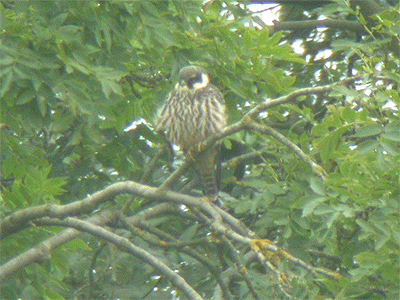 |
|
| ......... | ||
| Peregrine
Falcon Falco
peregrinus |
||
| A total of seven sightings, probably involving six different birds. An adult male was in the Eakring Flash/Leyfields area on February 8th, with no further records until May, when one moved south-east on May 10th, then an adult male moving east over Eakring Flash on May 14th. Autumn records included an adult female over Hare Hill Wood on October 11th and a juvenile female over Lound Wood on both October 25th and October 29th, with an adult male at Lound Wood on October 31st. | ||
| .... |
| Red-legged
Partridge Alectoris
rufa |
| Numerous sightings throughout the year, although there were no large counts made. |
| ......... |
| Grey Partridge Perdix perdix |
| The only large coveys noted, included groups of 14 at Penny Pasture Common on January 14th, followed later in the year by a group of 16 at Eakring Flash on October 18th. |
| ......... |
| Pheasant Phasianus colchicus |
| Very common throughout the area, with many released birds in the area during the latter half of the year. |
| ......... |
| Water Rail Rallus aquaticus |
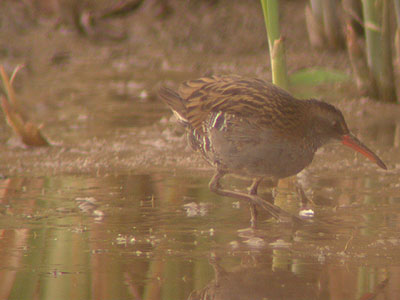 |
Records during the first part of the year
included three at Eakring Flash on January 3rd, with at
least one present at Eakring Flash from January 8-March
6th. First returning bird of the Autumn/Winter period was one at Eakring Flash from September 20-October 31st, with two present at Eakring Flash on October 24th. A short period with no sightings followed before one/two birds at Eakring Flash on numerous dates from November 5-28th. Early December possibly say an influx when four were at Eakring Flash on December 2nd, but then the only other record for the remainder of the month was of one at Eakring Flash on December 20th. |
|
| ......... | ||
| Moorhen Gallinula chloropus |
| Common across the area, with most small waters holding birds. |
| ......... |
| Coot Fulica atra |
|
| The first returning Coot of the year was late, undoubtedly due to the colder weather and not arriving at Eakring Flash until February 21st, with three present on February 26th. By March 3rd, a total of seven had arrived back. Breeding success was poor this year and there were no birds recorded after July. | |
| ......... |
| Oystercatcher Haematopus ostralegus |
| Two moving south-east over Eakring Flash on April 21st, was the only record. |
| ......... |
| Golden Plover Pluvialis apricaria |
| Another year of
relatively few sightings and the status of Golden Plover
as a regular Wintering bird in the area, has changed
quite considerably over the past few years. Flocks are
now uncommon to almost rare on the ground and all three
of the highest counts during 2009, came from over-flying
flocks. During the Winter/Spring period, these included
128 in the Red Hill area on January 10th and 158 west on
March 11th. One on August 30th, was the first of very few sightings during the Autumn, which did include 65 over Red Hill on October 18th. Cold weather towards the end of the year, saw numerous small groups totalling 269 moving south-west on December 20th. |
| ......... |
| Lapwing Vanellus vanellus |
| Some decent counts to
open the year with 42 in the area on January 4th, then
227 in the Red Hill area on January 10th. February
produced two notable records, with 65 briefly at Eakring
Flash on the 14th and 300 in fields adjacent to Penny
Pasture Common on 21st.
102 were at Eakring
Field Farm and a pair in territory at Park Farm on March
1st. Post breeding flocks disappeared very quickly, after 12 pairs attempted breeding. Breeding was confined to Park Farm, Eakring Field Farm, Red Hill and a pair (unusually) on pasture at Tug Bridge Farm. A varying-sized flock, peaked at 31 at Eakring Field Farm on October 24th, with 31 moving south-west on October 31st. Some good cold weather movements in December, first saw 37 moving west on December 19th, then 659 west on December 20th. |
| ......... |
| Jack Snipe Lymnocryptes minimus |
| All records came during the first three months of the year. There were no Autumn records, despite what seemed to be good numbers at many UK sites. All Eakring records were restricted to Eakring Meadows, with one January 2nd, four January 18th and one from January 29-30th. Other records were of one at Eakring Meadows, present from February 26-March 5th, then two on March 10th. |
| .... |
| Common Snipe Gallinago gallinago |
| Present in small numbers,
with relatively low counts throughout the course of the
year. 16 were at Penny Pasture Common on January 18th,
then just two at Penny Pasture Common on January 29th. A
count of nine at Eakring Flash (four) and Penny Pasture
Common (five) on February 14th, remained the best until
there were three back at Penny Pasture Common on April
22nd. The first Autumn record was a single moving west on September 12th, followed by small numbers on a few September and October dates. These included two north on September 17th, three west on September 20th, two west and five Penny Pasture Common on October 10th and four moving west on October 15th. Cold weather during December saw groups of seven moving west on December 19th and 17 moving west on December 20th. |
| ......... |
| Woodcock Scolopax rusticola |
| The year's only record was of one reproted as being disturbed from the rear yard at Park Farm, just after Christmas. |
| Whimbrel Numenius phaeopus |
| There were three Spring records, with six moving north over Red Hill on April 16th, six moving north-east over Eakring Flash on April 18th and two moving north over Eakring Flash on a heavily overcast May 14th. |
| ......... |
| Redshank Tringa totanus |
| One was at Eakring Flash briefly, before flying off west on July 26th. The first July date for Redshank here. |
| .... |
| Greenshank Tringa nebularia |
||
| There were two records involving three birds, which were the first at Eakring since 2006. One moved high west over Lound Wood and two were later at Eakring Meadows briefly, before they eventually moved off east on August 13th. | ||
| .... |
| Green
Sandpiper Tringa
ochropus |
| There were no Spring records again this
year, with all records coming during the Autumn. Most
records involved fly-overs or very brief staying birds,
but one did remain in the Eakring Meadows area for nearly
a full month. The full list of records were, one moving south-west over Eakring Flash on August 8th, three at Penny Pasture Common on September 19th, then flew north-west, one at Eakring Meadows on various dates between October 8-November 5th and finally one along The Beck at Eakring Flash on December 20th. |
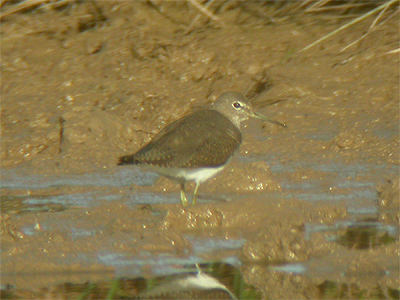 |
|
| .... | ||
| Black-headed Gull Larus ridibundus |
| There
were no large counts during January but February produced
35 south (1st) and 52 west on the 7th, which may have
been induced to move by the cold weather at the time.
February also saw the number of Black-headed Gulls
regularly using Eakring Flash increase, for the first
time in over ten years watching the site and an unusually
large count of 130, came on February 15th. Numbers after
this date, gradually declined and there were just odd
moving birds noted throughout much of March, April and
May. The first influx of post-breeding birds, came in July, with 44 moving south and west on July 18th. No similar counts followed until a few months later when 142 were in the area, then moved off west on October 31st. Higher counts coincided with a period of very cold weather in December, with 298 west and north-west on December 19th, 80 south and south-west on December 20th and 105 south and south-west on December 26th. |
| .... |
| Common
Gull Larus
canus |
||
| There were no large numbers recorded during the year, but Common Gulls were in the area on many dates. One at Eakring Flash on April 9th, was a relatively late and unusual date for Common Gull at Eakring and this was the last until a 1cy through Eakring Flash on August 29th. The only other notable count coincided with a cold weather Black-headed Gull movement, of 29 moving west and north-west on December 19th | ||
| .... |
| Lesser
Black-backed Gull Larus fuscus graellsii |
| Typically, there were very few records until mortherly moving migrants started moving through the area in March. From late Summer, numbers gradually increased from 36 in fields at Red Hill on July 30th and peaking at a massive 1 200 in fields at Leyfields on August 13th. Good numbers were in the area daily until early November, but some detectable genuine late movement occurred with 95 south-west on November 5th and 65 on November 28th. |
| .... |
| Herring Gull Larus argentatus |
| Some very
good counts made this year, with several definite
influxes noted during October and December. Probable
feeding movements were 46 south-west on January 4th and
77 south-west on January 18th. Much larger counts
included 165 south-west on January 10th and 152 on
February 1st. The Autumn saw the first influxes when 32 south-west on October 11th and 42 south on October 18th. December provided more decent counts with 67 south-west on December 13th, 106 south and south-west on December 20th and 80 south and south-west on December 26th, but these latter two counts may have been more weather related. |
| .... |
| Yellow-legged
Gull Larus
cachinnans michahellis |
| Just one record for the year, coming typically in late Summer when a 3cy bird was in fields near Tug Bridge Farm on August 9th. |
| .... |
| Great
Black-backed Gull Larus marinus |
| A very
similar situation to Herring Gull, with some excellent
area counts made on virtually the same dates. These
included 75 south-west on January 10th and 44 south-west
on January 18th. A count of 42 Great Black-backed Gull north on March
15th, was the only significant northerly movement by this
gull in over ten years here and odd records included a
single moving south-west on April 13th, then eight moving
south on April 21st. Even more out of context, were two
moving south-east on the unusual date of May 14th. A single moving south-west on September 27th, was the first of the Autumn, with influxes of 16 south-west on October 11th and 30 south and south-west on December 13th. New consequtive record counts occurred with 99 south and south-west on December 20th and 119 south and south-west on December 26th. |
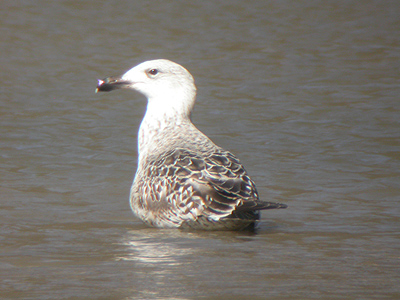 |
|
| .... | ||
| Kittiwake Rissa tridactyla |
| An adult was observed from the car, flying low north over fields in windy conditions at 15:15h on March 28th. It was followed as it flew north-west over Wellow (at little more than roof top height) before being relocated again, heading north over the traffic island on the A614 at Ollerton. The 4th Eakring record. |
| .... |
| Common Tern Sterna hirundo |
| Three records this year. One present at Eakring Flash for several hours from first light, eventually moved off north when joined by a second bird on April 16th. There was a further Spring record of one moving north on May 14th. One moving west on July 30th, was the only other record. |
| .... |
| Feral Rock Dove Columba livia |
| Common in varying numbers at all times of the year. |
| .... |
| Stock Dove Columba oenas |
| Fairly common in the recording area. Occasionaly migrants were recorded moving in February and April in the Spring months, then in September, October (a peak of eight) and November during the Autumn. Despite being looked for, no Stock Doves were picked out among migrating Wood Pigeon flocks this year. |
| .... |
| Wood Pigeon Columba palumbus |
| There were few Spring migrants noted, but a good Autumn passage began with 154 south on October 18th and 837 south-west on October 29th, reaching a peak of 5 439 moving south on November 5th. Futher movement continued on suitable mornings in November, with 883 south-west on November 8th, before 1 078 returning back north-west on November 15th - a feature noted previously before at Eakring and elsewhere in the UK this year. |
| .... |
| Collared Dove Streptopelia decaocta |
| Present in continuing good numbers at most areas of human habitation. Throughout both Spring and Autumn, determined efforts were made to check for migrant Collared Doves, resulting six birds north in Spring and seven south in Autumn. |
| .... |
| Turtle Dove Streptopelia turtur |
| Year | Jan | Feb | Mar | Apr | May | Jun | Jul | Aug | Sep | Oct | Nov | Dec | Total | |
| . | . | . | . | . | . | . | . | . | . | . | . | . | . | . |
| 1998 | . | .. | .. | . | 15 | . | 9 | 21 | 2 | . | . | . | . | 47 |
| 1999 | . | . | . | 1 | 23 | . | 12 | 36 | 3 | . | . | . | . | 75 |
| 2000 | . | . | . | 1 | 1 | 1 | 11 | 14 | 3 | . | . | . | . | 31 |
| 2001 | . | . | . | . | 15 | . | . | 4 | 3 | . | . | . | . | 22 |
| 2002 | . | . | . | 1 | 2 | . | 13 | 24 | 2 | . | . | . | . | 42 |
| 2003 | . | . | . | . | 10 | . | 2 | 10 | 20 | . | . | . | . | 42 |
| 2004 | . | . | . | . | 8 | . | 5 | 2 | 4 | . | . | . | . | 19 |
| 2005 | . | . | . | 5 | 2 | . | 4 | 1 | . | . | . | . | . | 12 |
| 2006 | . | . | . | . | 4 | . | 14 | 1 | 1 | . | . | . | . | 20 |
| 2007 | . | . | . | .. | 3 | .. | 5 | 10 | 4 | .. | .. | .. | .. | 22 |
| 2008 | . | . | .. | 3 | 6 | . | 1 | 4 | 13 | . | . | . | . | 27 |
| 2009 | . | . | . | 1 | . | . | . | 3 | . | . | .. | . | . | 4 |
| .... |
| A disastrous year for migrant numbers (compare in the above table) although the tiny breeding population remained at just two pairs for the second year running. The only Spring migrant went south-east on April 27th and August provided all three Autumn migrants. |
| .... |
| Cuckoo Cuculus canorus |
| A male was calling for about 15 minutes, in trees near Eakring Flash on May 9th and was the first here for two years. |
| .... |
| Barn
Owl Tyto
alba |
|||
| A pair were back at their usual territory in April. | |||
| .... | |||
| Little Owl Athene noctua |
| Little study was done on all of the area's owls in 2009 and only two LittleOwl pairs were seen during the year. One of the long staying pair near Eakring Field Farm, was killed by traffic during the breeding season. |
| .... |
| Tawny Owl Strix aluco |
| At least five pairs bred again during the Summer. |
| .... |
| Long-eared Owl Asio otus |
| The regular roost near Kersall provided records of one on February 21st and two on March 5th (per Robin Brace and Tony Wardell) |
| .... |
| Swift Apus apus |
|
| Arrival was late this year, despite good numbers at the larger Nottinghamshire waters well before the first at Eakring on May 7th. There was little Autumn migration detectable this year, the best of any counts being 120 moving south-east on August 1st. There were no September records. | |
| .... |
| Kingfisher Alcedo atthis |
| Sightings were rather sporadic, with most coming in the post-breeding period from July-September. Recorded from Eakring Flash, Red Hill and Eakring Meadows during the year. |
| .... |
| Green Woodpecker Picus viridis |
| Just one pair present throughout the year, with a pair breeding in Lound Wood. Birds were occasionally noted from Eakring village, Red Hill and Eakring Flash. |
| .... |
| Great Spotted
Woodpecker Dendrocopos
major |
| Noted virtually daily, with sightings involving one/three birds throughout the year. Breeding again took place at Lound Wood and Hare Hill Wood. |
| .... |
| Wood Lark Lullula arborea |
| One moving south-east over Lound Wood September 27th, was the only record. |
| .... |
| Sky Lark Alauda arvensis |
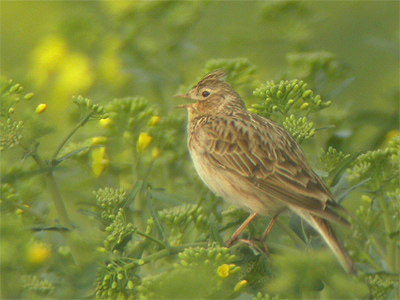 |
The opening months of
2009 opened with a period of cold weather and although
there were no large cold weather migration counts made
from other UK sites, there was clear evidence that Sky
Larks were affected by the weather. A flock of 31 at Eakring Flash on January 10th, would normally have been notable, but just a month later, a flock of at least 250 Sky Lark were in fields near Church Hill and Leyfields on February 8th. There were still 138 present at Leyfields on February 14th. There was some light Autumn passage during late September, October and into November, the best of which was 31 moving west on October 17th. |
|
| .... | ||
| A period of very cold weather with snow, induced some movement, with 68 south-west on December 20th and 27 moving south-east and south-west on December 26th. | ||
| .... | ||
| Sand Martin Riparia riparia |
| A generally poor year this year, with both migration periods providing only small numbers. First of the year was one moving north-east over Eakring Flash on April 2nd. Autmn migration began from mid-July, with a peak of 16 at Eakring Flash on August 13th. Last of the year was a single through on September 3rd. |
| .... |
| Swallow Hirundo rustica |
| Arrival from April 1st, but only light passage through the whole of the Spring period. Peak movement came on April 16th with 28 north. A poor Autumn migration followed and the best of the daily counts included 30 moving south on August 22nd, 38 south on August 23rd, 51 south on September 3rd and a peak of 125 south-east and north on September 20th. Last of the year was one at Eakring Flash on October 11th. |
| .... |
| House Martin Delichon urbica |
| Spring arrival commenced with one at Tug Bridge Farm on April 11th. As with other hirundines, migration counts were poor during both Spring and Autumn. Return movement was evident from mid-July with 31 moving south on July 19th. The best of the other counts were 30 moving south on August 1st, 32 south-west on August 19th and 80 south-west on September 5th. |
| .... |
| Tree Pipit Anthus trivialis |
| One moving north-west over Eakring Flash on April 23rd, was the only Spring record. There were three Autumn records, all of which occurred in August with one at Eakring Flash, then flew south (8th) one at Eakring Meadows (19th) and one moving south (23rd) |
| .... |
| Meadow Pipit Anthus pratensis |
| Just steady passage noted
during both migration periods. Best of the Spring counts
were 37 moving north-west on March 14th, 55 moving
north-west on March 15th, a Spring peak of 104 moving
north-west on March 29th and 45 moving north-west April
5th. First birds of the Autumn were seen in late July, but there was to be no large movment. 77 moving south-east on September 19th, then 69 south-east on September 20th amd 72 south-east on September 24th, all preceded a peak of 224 moving south on September 26th. |
| .... |
| Rock Pipit Anthus petrosus petrosus |
| A single moving west over Eakring Flash on October 18th, was in line with previous Rock Pipit records here. There have been five records in total (including 2009) all occurring between October 4th and 21st and of birds moving west. |
| .... |
| Yellow Wagtail Motacilla flava flavissima |
| Arrival from April 1st, which represented the earliest ever date here. Despite a promising start, there was another decline in the number of migrant Yellow Wagtails again. Spring passage was however, relatively normal by recent standards, but just ten Autumn records was dire, especially given the amount of on-site coverage. Two pairs bred in the area during the Summer. |
| .... |
| Year | Jan | Feb | Mar | Apr | May | Jun | Jul | Aug | Sep | Oct | Nov | Dec | Spring | Autumn | Total | |||
| 1998 | . | . | . | 41 | 13 | . | 3 | 43 | 32 | . | . | . | . | 54 | . | 78 | . | 132 |
| 1999 | . | . | . | 35 | 9 | 1 | 8 | 59 | 27 | . | . | . | . | 45 | . | 94 | . | 139 |
| 2000 | . | . | . | 33 | 4 | . | 7 | 66 | 71 | . | . | . | . | 37 | . | 144 | . | 181 |
| 2001 | . | . | . | 31 | 23 | . | . | 35 | 38 | . | . | . | . | 54 | . | 73 | . | 127 |
| 2002 | . | . | . | 13 | 9 | . | 7 | 59 | 40 | . | . | . | . | 22 | . | 106 | . | 128 |
| 2003 | . | . | . | 8 | 18 | . | 1 | 36 | 15 | . | . | . | . | 26 | . | 52 | . | 78 |
| 2004 | . | . | . | 13 | 8 | . | 3 | 17 | 2 | . | . | . | . | 21 | . | 22 | . | 44 |
| 2005 | . | . | . | 20 | 16 | . | 6 | 11 | 10 | . | . | . | . | 36 | . | 27 | . | 63 |
| 2006 | . | . | . | 33 | 1 | . | 7 | 43 | 5 | . | . | . | . | 34 | . | 55 | . | 89 |
| 2007 | . | . | . | 18 | 1 | . | 4 | 65 | 45 | . | . | . | . | 19 | . | 114 | . | 133 |
| 2008 | . | . | . | 17 | 6 | . | 12 | 13 | 9 | . | . | . | . | 23 | . | 34 | . | 57 |
| 2009 | . | . | . | 21 | 1 | . | 3 | 5 | 2 | . | . | . | . | 22 | . | 10 | . | 32 |
| .... | ||
| The low number of Yellow Wagtails in 2009 came as something of a surprise, even considering that the number of passage birds has generally dropped here in both migration periods since 2002, with 2007 being the only exception in the last seven years. Surprisingly, the lack of Yellow Wagtails this Autumn, seems to have passed virtually unnoticed in birdwatching circles. | ||
| .... |
| Grey Wagtail Motacilla cinerea |
| Recorded largely as a passage migrant this year. Spring produced just one record of a single moving north on March 1st. The first of ten Autumn migrants went west on September 5th, then another high south on September 13th. September proved to be the peak month with eight records. Single birds were also regular at Penny Pasture Common and Eakring Flash from September and into October. |
| .... |
| Pied Wagtail Motacilla alba yarrelli |
| Low migration counts again this Spring, with a typical March peak of just 18 through during the month. Autumn migration was better, but still nowhere near the numbers of several years ago. The migrant total for September was 33, almost equal the total of 34 reached in October. A small roost developed at Eakring Flash during the early Winter period, with a maximum of 40 present on December 2nd. |
| .... |
| White
Wagtail Motacilla alba |
| There were just two records this year, with one at Eakring Meadows on April 1st and a male in fields near Penny Pasture Common on October 11th. |
| .... |
| Wren Troglodytes troglodytes |
| Very common throughout the area. |
| .... |
| Dunnock Prunella modularis |
| Common. Some typical local movement was evident between September 19th and October 11th, with 11 recorded in September, compared to just two in October. |
| .... |
| Robin Erithacus rubecula |
| Very common throughout the area. |
| .... |
| Redstart Phoenicurus phoenicurus |
| Two records. A male was at Penny Pasture Common on April 11th, was the 50th Redstart at Eakring in 12 years. A female/immature was also at Penny Pasture Common on August 27th. |
| .... |
| Whinchat Saxicola rubetra |
| One of the most affected migrants, which has seen numbers plummet in recent years. Whinchat was formerly quite a common species, with counts in 1998-2003 virtually double subsequent years. 2009 provided just one record, of a juvenile at Penny Pasture Common on August 8th. |
| .... |
| Stonechat Saxicola torquata |
| Two records. A female was present along a ditch at Church Hill from March 5-6th, occurring just a few days after numbers arrived on the south coast. Another female turned up at Eakring Flash on the afternoon of October 29th. |
| .... |
| Wheatear Oenanthe oenanthe oenanthe |
 |
The first of the Spring,
were a pair at Eakring Flash on March 29th. In April,
Wheatears included a female at Tug Bridge Farm (5th)
followed by males at Penny Pasture Common (9th) Eakring
Flash (12th) and Tug Bridge Farm (25th) A good arrival of
a site record eight birds occurred on April 26th, with
five (three females and two males) in fields at Park Farm
and three (two males and a female) turned up in the large
pasture at Tug Bridge Farm. Two different birds the next
day, included another female at Park Farm and a
long-staying male at Tug Bridge Farm, which remained for
11 days till May 7th. Wheatear is much less common here during Autumn passage, so it was nice to get singles at Eakring Flash on August 13th and a 1st Winter male at Eakring Flash again on September 5th. |
|
| .... | ||
| Ring Ouzel Turdus torquatus |
| Two 1st Winter birds were a surprise find feeding on Rowan berries near Kneesall on August 27th, but flew into deep cover and were not relocated despite much searching. |
| .... |
| Blackbird Turdus merula |
| The only real influxes occurred at Penny Pasture Common on October 15th, where there were slightly increased numbers of Blackbirds, which also including a striking pale brown coloured bird. A second influx was noted on October 22nd, with 20+ Blackbirds along a short stretch of hedgerow in the pastures area. |
| .... |
| Fieldfare Turdus pilaris |
| The year opened with
relatively small numbers in the area, compared to most
other years, with 43 at Tug Bridge Farm on January 3rd
and 80 at Eakring Meadows on January 30th, being the best
of any counts. There was to be no large build up in
numbers, prior to return migration, with the best counts
during the Spring being of 190 north and north-west on
March 15th and a flock of 94 at Church Hill on March
26th, rose to 172 by April 4th. Last birds of the Spring
were six on April 11th. The big influx days of the Autumn occurred during mid-week and were missed through work commitments. The best movements recorded were 809 west on October 17th, 99 south-west on October 18th and 245 (which included a flock of approximately 180 at Penny Pasture Common) on November 5th. |
| .... |
| Song
Thrush Turdus
philomelos |
||
| A poor year for migrants with both migration periods producing the second lowest total since 1998. There was no effort made to monitor breeding successes in the area during the Summer months, but also no indication of any drop in the breeding population here. | ||
| .... |
| Redwing Turdus iliacus |
| Redwing remained almost
absent during the Winter/Spring period, with counts never
reaching double figures. A single bird was still at
Kersall on April 11th. Two moving west on September 26th, were the first Autumn arrivals and the big influx days were missed through a mid-week occurrence and work commitments. Best of the counts when actually on site were 276 moving south-west on October 11th and 332 south-west on October 15th. There was clear evidence of some effects of the very cold weather towards the end of December, when several groups totalling 41, moved south and west on December 26th. |
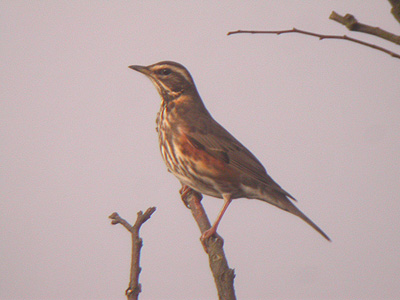 |
|
| .... | ||
| Mistle Thrush Turdus viscivorus |
| Efforts to determine any genuine Mistle Thrush migration patterns were made during the year. Migration was found to peak in September, based on a low total of seven migrant birds. |
| .... |
| Year | Jan | Feb | Mar | Apr | May | Jun | Jul | Aug | Sep | Oct | Nov | Dec | . | Total |
| . | . | . | . | . | . | . | . | . | . | . | . | . | . | . |
| 2009 | . | . | . | . | . | . | . | . | ..6 | 1 | . | . | . | ..7 |
| .... |
| Grasshopper
Warbler Locustella
naevia |
| Arrival was from April 18th with a male at Penny Pasture Common until July 26th at least and attracting a female on April 28th. A second male was also at Penny Pasture Common on April 26th. A juvenile was loosely associating with a mixed flock of warblers at Eakring Flash on July 30th. |
| .... |
| Sedge Warbler Acrocephalus schoenobaenus |
| A drop in numbers this year, after an early arrival at Eakring Flash on April 18th (same day as Grasshopper Warbler) A second bird arrived at Eakring Flash on April 20th, but there were no other new Sedge Warblers until April 29th. Breeding was confined to Eakring Flash, where just three pairs bred. There were three late Summer and Autumn records, with singles along the old hedge at Eakring Flash on July 30th, August 1st and August 8th. |
| .... |
| Reed Warbler Acrocephalus scirpaceus |
| One pair
bred successfully at Eakring Flash. A male singing at
Eakring Flash on May 22nd, was the first of the Spring
but proved elusive. Regular singing was from July 18th,
but there was no sign of any birds between these dates.
By late July, there were definitely two males and a
female at Eakring Flash (July 25-August 8th). Young were
still being fed in the nest on July 25th. Additional sightings of probable migrants were again at Eakring Flash from August 22-23rd and a juvenile in Elders near Eakring Flash on September 20th. |
| .... |
| Lesser
Whitethroat Sylvia
curruca |
| Arrival in Spring on April 21st, with one at Eakring Meadows. Main arrival was from April 25th and a full Spring total of seven was slightly down on recent years. Seven migrants also made up the Autumn total, with a peak (unusually) in July this year. Last of the Autumn was one at Penny Pasture Common on September 12th. |
| .... |
| Whitethroat Sylvia communis |
||
| Arrival was sudden, with four on April 20th and four new birds in on April 21st. Further arrivals continued in the last week of April and there was one which arrived in May. Autumn produced a total of 63 migrants, with a peak of 34 coming in August. Last of the year was at Eakring Flash on September 24th. | ||
| .... |
| Garden Warbler Sylvia borin |
| Arrival at Kersall was from April 30th at the latest, with a pair already in territory. The only other Garden Warbler recorded was a singing male at Tug Bridge Farm on May 9th. There were no Autumn records. |
| .... |
| Blackcap Sylvia atricapilla |
| All Spring arrivals (total of 28 birds) were in April this year, following one at Oil Bore Holes on April 5th. Just seven Autumn migrants made 2009 a very poor year for the species, with the same total last achieved in 2007. |
| .... |
| Chiffchaff Phylloscopus collybita |
| Two at Eakring village and the eastern-end of Eakring Meadows on March 21st, were the first of the Spring. During April, a total of 25 migrants were recorded, including five new birds on April 2nd. The late Summer and Autumn period saw much better numbers, with an earlier than normal peak in migrants reached in August. Two on October 1st, were the last of the year. |
| .... |
| Willow Warbler Phylloscopus trochilus |
| Two at Eakring Flash and
Red Hill on April 5th, were the first of the year. On the
whole, the number of passage Willow Warblers was slightly
disappointing and there seems to be something of a
gradual decline in passage numbers since 2004. The drastic decline in breeding numbers noted here in 2008, continued this year and only six pairs bred again in 2009. Return migration was evident from early July, with numbers peaking at 42 in August which is unusually in line with Chiffchaff. There were no further records after one at Eakring Flash on September 13th. |
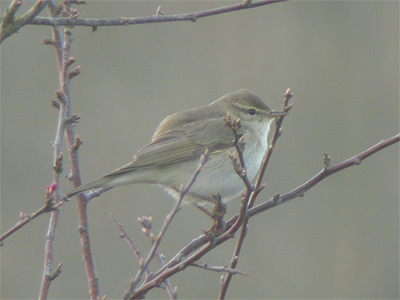 |
|
| .... | ||
| Goldcrest Regulus regulus |
| Just one Goldcrest at Eakring Meadows NR in September, turned out to be the only 2009 record, apart from Eakring's very small, resident breeding population (two pairs at Lound Wood) and it seems that something went definitely wrong this Summer, both here in the UK and across the North Sea in northern Europe. An almost complete lack of Goldcrests was also commented on by several observers at other UK migration watchpoints. |
| .... |
| Spotted
Flycatcher Muscicapa
striata |
| Another poor year. One pair returned to breed at a site in Eakring village, where they also bred last year. The only Autumn migrant was a single at Eakring Meadows on August 29th. |
| .... |
| Long-tailed Tit Aegithalos caudatus |
| Common throughout the area. A flock of 21 was at Eakring Flash on October 31st. |
| .... |
| Marsh Tit Parus palustris |
| Uncommon here, with two pairs breeding at Lound Wood and Hare Hill Wood. Two isolated records were singles at Eakring Meadows on November 5th and December 5th. |
| .... |
| Willow Tit Parus montanus |
| During the year, was recorded at Lound Wood, Eakring Flash, Eakring Meadows, Penny Pasture Common, Oil Bore Holes and High Trees. Two pairs occupied territory during the breeding season. |
| .... |
| Coal Tit Parus ater |
|
| A small breeding population was evident again this year, with just two pairs found in Lound Wood. The number of migrant/passage birds was also low, with two in August and two in September. | |
| .... |
| Blue Tit Parus caeruleus |
| Very common throughout the area. |
| .... |
| Great Tit Parus major |
|
| Common and regular at all sites. | |
| .... |
| Nuthatch Sitta europaea |
| One/two were at Lound Wood from July 30th onwards. |
| .... |
| Treecreeper Certhia familiaris |
| Recorded from Lound Wood, Hare Hill Wood, Eakring Meadows, Red Hill and Penny Pasture Common during the year. Breeding birds remained confined to both the recording area's woodlands, where two pairs bred at Lound Wood and just one at Hare Hill Wood. |
| .... |
| Jay Garrulus glandarius |
|
| At least one pair were in the area throughout the year, with breeding unconfirmed. Possible early migrants/dispersing birds included three north on July 30th and two at Red Hill on August 1st. Jays with considerably better credentials for being migrants/dispersing birds included ten in September and five during October. | |
| .... |
| Magpie Pica pica |
|
| Common across the area, although the population is perhaps lower than would be expected. | |
| .... |
| Jackdaw Corvus monedula |
| Common throughout the year and seen on a daily basis. Breeding birds are concentrated at High Trees on the eastern side of Eakring village and at Lound Wood, although there are odd pairs occupying roadside trees at several other locations. A count of 46 on October 24th, was the highest of the year. |
| .... |
| Rook Corvus frugilegus |
| Very common and recorded daily. Several counts of over 300 were made outside the breeding season. |
| .... |
| Carrion Crow Corvus corone corone |
| Common throughout the recording area. |
| .... |
| Starling Sturnus vulgaris |
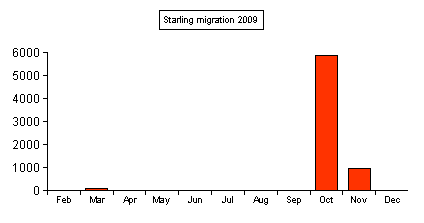 |
There were only low
numbers recorded during the early months of 2009. Some
evidence of return migration, with 12 north-west and 60
east on March 15h, the only determined movement recorded
during the Spring. An excellent period of prolonged Autumn movements came after nine moving west on September 24th. October saw a record passage, with a monthly total of nearly 6 000 birds. Best of October's counts were 205 west on October 10th, 385 west on October 15th, 937 south-west on October 17th, 2 032 west on October 18th, 515 west on October 22nd, followed by 1 011 west on October 29th and 544 north-west on October 31st. |
|
| .... | ||
| There was continued movement during early November (although now much reduced) the best of which was 438 west on November 7th. | ||
| .... | ||
| House Sparrow Passer domesticus |
| No survey attempt was made this year, but still remains common in both Eakring and Kersall villages, with smaller populations around all farms in the area. |
| .... |
| Tree Sparrow Passer montanus |
| A peak count of 18 at Penny Pasture Common was made on August 22nd. The late Summer and early Autumn periods, saw a total of 14 migrants move through, with a peak of six through during August. |
| .... |
| Chaffinch Fringilla coelebs |
| Remains an extremely common breeding bird here. There was little migration evident during the Spring period, with only very small numbers noted. Things were considerably better during the Autumn, when migration occurred almost daily from September to November. |
| .... |
| Year | Jan | Feb | Mar | Apr | May | Jun | Jul | Aug | Sep | Oct | Nov | Dec | . | Total |
| .... | .... | .... | .... | .... | .... | .... | .... | .... | .... | .... | .... | .... | . | .... |
| 1998 | .... | .... | .... | .... | .... | .... | .... | .... | 89 | 491 | 183 | .... | . | 763 |
| 1999 | . | . | 7 | . | . | . | . | 9 | 73 | 456 | 16 | . | . | 571 |
| 2000 | . | . | 9 | . | . | . | . | 2 | 200 | 298 | 160 | . | . | 669 |
| 2001 | . | . | 3 | . | .. | . | . | . | 201 | 522 | 125 | . | . | 851 |
| 2002 | . | .. | 15 | . | . | . | . | . | 164 | 297 | 14 | 6 | . | 496 |
| 2003 | 4 | 6 | 10 | . | . | . | . | 3 | 44 | 77 | 58 | 5 | . | 207 |
| 2004 | . | . | 9 | 13 | . | . | . | . | . | 5 | 48 | 28 | . | 103 |
| 2005 | . | 3 | 13 | . | . | . | . | . | 5 | 75 | 22 | 8 | . | 125 |
| 2006 | . | . | 11 | 5 | . | . | . | . | 68 | 119 | 37 | 10 | . | 250 |
| 2007 | 3 | 2 | 9 | 63 | 464 | 18 | . | . | 559 | |||||
| 2008 | . | 2 | 3 | 2 | . | .. | . | . | 65 | 526 | 34 | 7 | . | 639 |
| 2009 | . | 7 | 2 | 13 | . | . | . | . | 85 | 405 | 64 | 2 | . | 578 |
| .... |
| Well over 550 Chaffinches were recorded and again, the direction was biased towards a westerly direction and probably indicating birds of a continental origin. The best of the daily movements were 31 north-west on September 26th, 39 south-west on October 11th, 70 west on October 15th, 72 west on October 17th, a peak count of 93 west on October 18th and 63 west on October 29th. Movements tailed off in November and there was possibly some indications of odd birds moving south during very cold weather in mid-December. |
| .... |
| Brambling Fringilla montifringilla |
| Brambling records in the early months of the
year are uncommon and the 21 moving north over Hare Hill
Wood on February 21st, actually beat any daily Autumn
count here. There were several other Spring records,
concerning one at Eakring Meadows on March 3rd, one at
Eakring Flash on March 5th and three moving north with
six Fieldfare on April 11th. It was another poor Autumn and the only records were four moving west on October 11th, followed by singles moving west October 18th, at Eakring Meadows October 22nd, moving west October 25th and moving south-west October 29th. |
||
| .... |
| Greenfinch Carduelis chloris |
| Remains a fairly common breeding bird. A Spring migrant total of 16 was poor, based on previous years. There was the usual Autumn peak October of 92, which was the best total since 2002. The highest daily counts actually came during November with 25 south on the 8th. December saw a varying sized flock feeding on an old Sunflower crop in the Red Hill area, which often numbered 60+ birds. |
| .... |
| Goldfinch Carduelis carduelis |
| There was a good Spring passage through the area, especially during April with a monthly count of 69, very nearly eclipsing that reached in 2001. Autumn migration was poor and despite taking place between August and December, 33 Goldfinch through in October, represented yet another average Autumn maximum. |
| .... |
| Siskin Carduelis spinus |
| Recorded purely as a passage migrant and Winter visitor. Spring migration peaked in April, with a flock of 13 moving north-west on April 22nd, being just part of a Spring total of 26 migrant Siskin. The Autumn saw a total of 109 birds through, mostly ones or twos, but flocks of 23 moving south-east on October 15th and 12 moving south-east on December 5th, were more notable. |
| .... |
| Linnet Carduelis cannabina |
| A total of 117 migrants
moved through during the Spring, with a peak of 102 in
April. The most notable daily count was of just 18 moving
north-west on April 12th. Although Autumn movements were higher, they were still quite poor in comparison with some previous Autumns. September produced the following counts, including 45 at Eakring Flash on September 17th, 34 moving south on September 19th and 69 moving south on September 26th. A varying sized flock built up during October, to produce a peak of 200 at Eakring Flash on October 22nd. There was only limited movements during November and no flocks of any size for the early Winter period. |
| .... |
| Lesser Redpoll Carduelis cabaret |
| Migrants were recorded in every month outside the period June to September. Spring migration was limited to a monthly eak of just five in April. The first Autumn birds appeared in October and the best daily count was of ten moving south-east on October 31st. |
| .... |
| Common Crossbill Loxia curvirostra |
| Two records, with one moving north-west over Eakring Flash on July 25th and two moving north-west over Lound Wood on October 31st. |
| .... |
| Bullfinch Pyrrhula pryyhula |
| Noted regularly at many
sites during the course of the year. October and early November was notable for the most obvious movement of Bullfinches through the area, with an October total of 20 being partly made up of nine through on the 29th. Bullfinch have never really been thought of as true migrants by many experienced visible migration observers and previous movements here, have always been attributed to localised feeding movements. Autumn 2009 though, saw single birds or small groups moving through high up and in similar fashion to other migrant finches. Clearly, there was obvious movement taking place and this was similarly noted at many other UK sites during October and early November. During both months, Bullfinches were unusually found to be present at most sites visited, this alone being a strong indication of immigration. |
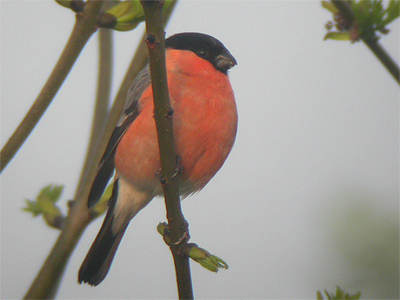 |
|
| .... | ||
| The origin of this UK migration is largely believed to be from northern areas of the UK. Although they are regularly recorded most Autumns in some parts of northern Europe, migration does not generally involve larger northern race birds. Previous Eakring movements, which we had previously regarded as localised movers and now seem to have been genuine migrants, include seven (October and November 2003) and one in August 2005. | ||
| .... | ||
| Yellowhammer Emberiza citrinella |
| Still common throughout the recording area. Some notable migration during the Autumn, with 27 moving through south-west on October 11th, which included a single flock of ten birds. A total of 64 migrants were recorded during both migration periods. |
| .... |
| Reed Bunting Emberiza schoeniculus |
| Remains common, with breeding confined to Eakring Flash, Penny Pasture Common and Eakring Meadows. There was some limited migration during both Spring and Autumn, with a typical peak coming in October. |
| .... |
| Corn Bunting Miliaria calandra |
| One moving north over Eakring Flash on April 9th, was the only record. |
| .... |
| Unconfirmed reports |
| .... |
| There were reports of a Pied Flycatcher (September 25th) and a male Hen Harrier (mid-November) from Penny Pasture Common. An attempt was made to contact the webmaster of the NBW website, to obtain the observers name with a view to contacting them about the sightings, but who witheld the information as it was against the law (presumably on the grounds of the Data Protection Act) These reports are therefore, not contained in the 2009 systematic list. |
| Escapes |
| .... |
| Harris Hawk Parabuteo unicinctus |
| One being mobbed by corvids at Hare Hill Wood on October 18th. |